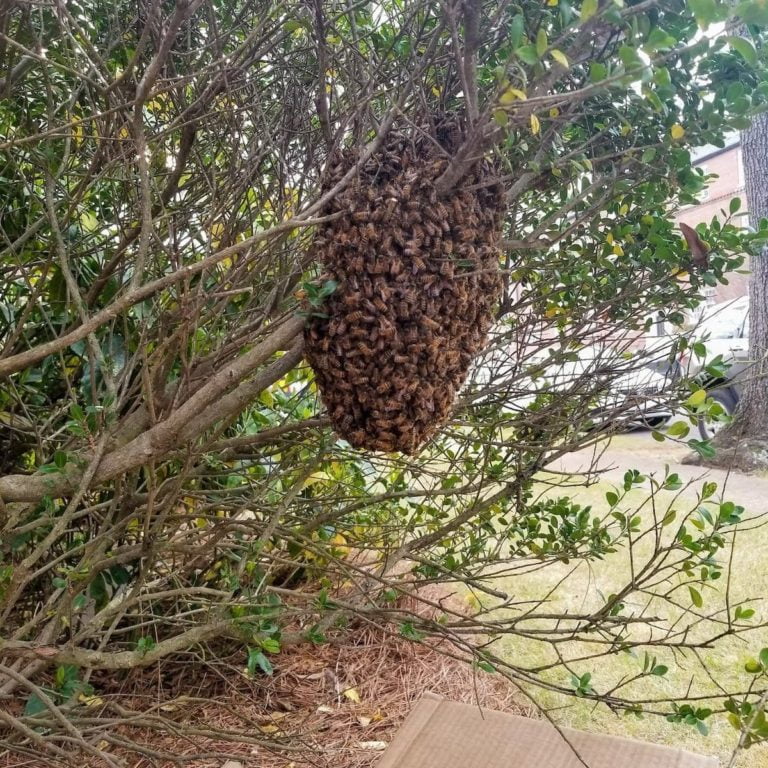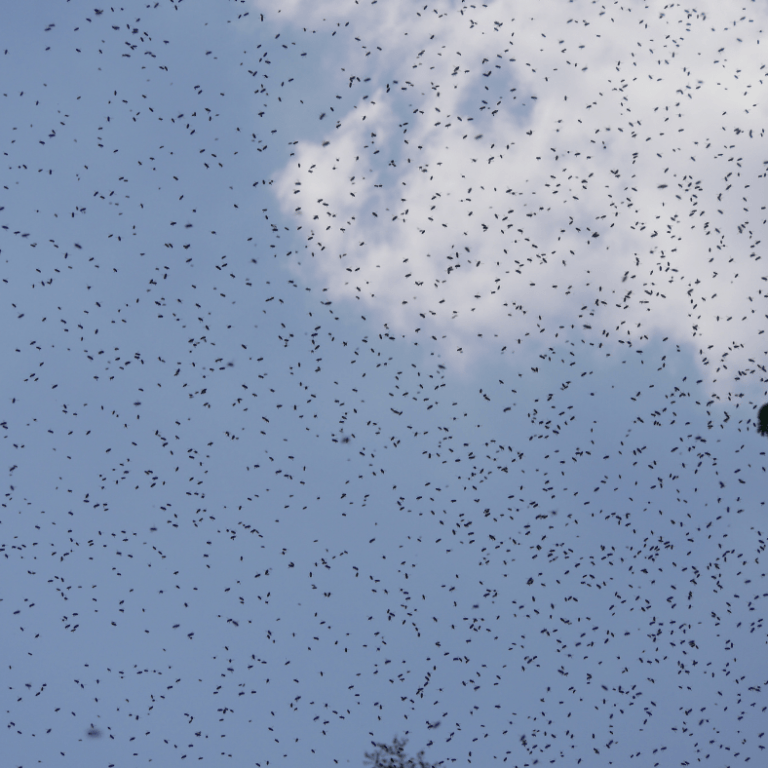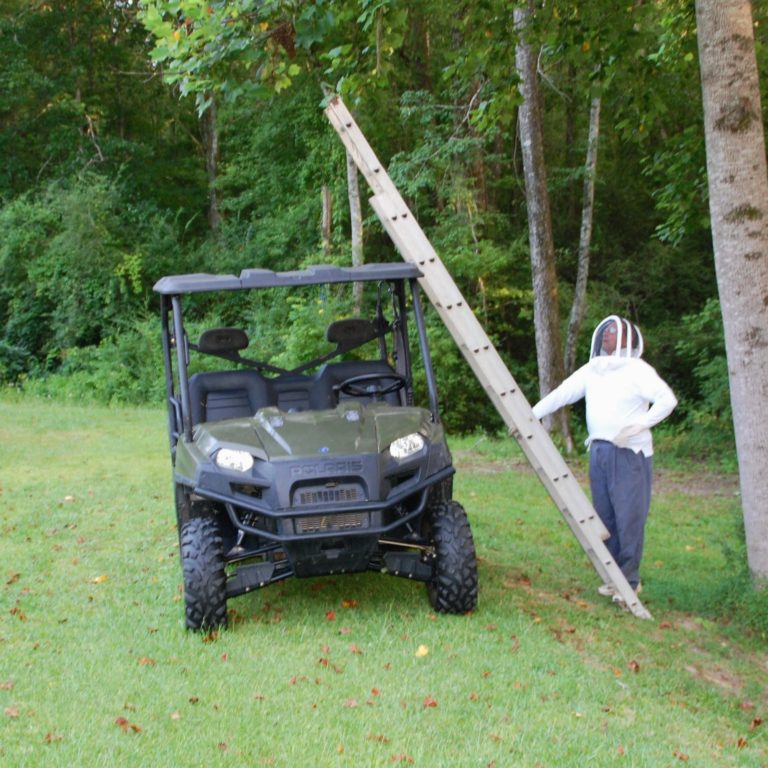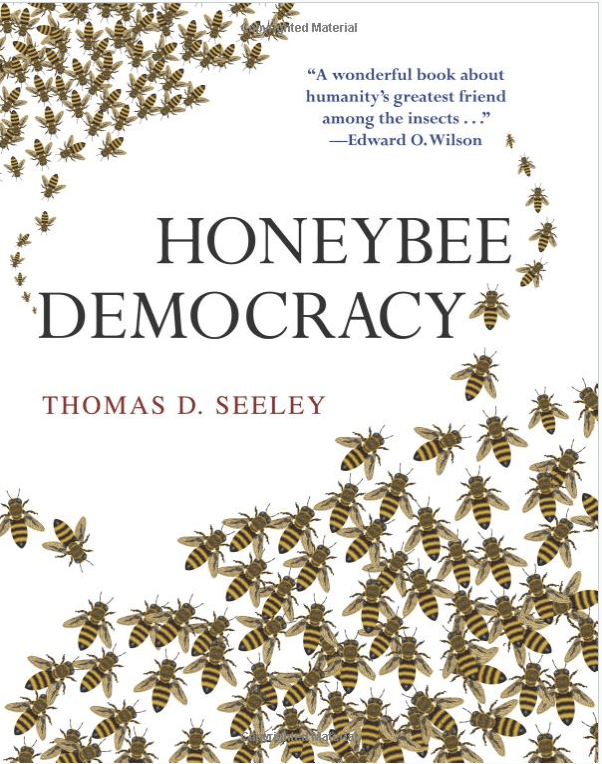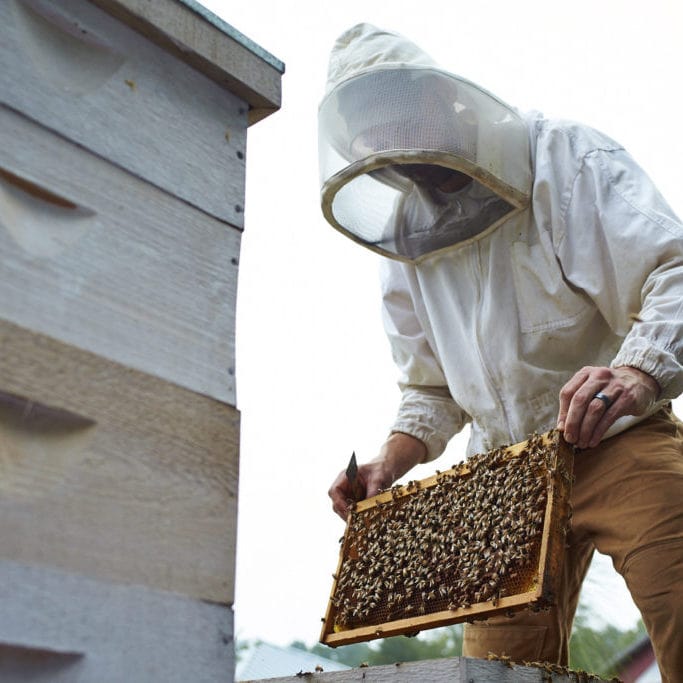Just the idea of a swarm of bees makes you think of horror movies or maybe something that gives you the chills just thinking about it. To the average person, a swarm of honey bees sounds like a nightmare, but it is actually a very unique time in the bee’s life where they are the least likely to sting and are the most interesting to watch. More on this later.
The good news is that if you see a swarm of bees, it isn’t a cause to panic, run in fear, spray them with a hose or get out a can of wasp spray. There are two things you should do (if you are not a beekeeper).
- Call a beekeeper
- Do Nothing and watch them
A swarm of honey bees is a natural event where one colony divides into two. The original colony makes several more queen bees to replace the previous queen. Nearly half the bees leave the colony with the old queen, with only the wings on their back, to find a new place to live. They leave behind the original colony and hive with their new queen and set their sights on building a new home. When you see a swarm of bees hanging on your tree, mailbox or flying through the air in a big cloud of swirling bees, this is the swarm.
For somebody wanting to get into beekeeping and is looking for bees, a swarm is one of the ways you can start a colony.
What Do I Do When I Find A Swarm?
When you see a swarm of bees, they tend to get a bit intimidating. Images of killer bees coming to get you might be scary. Depictions and images of bees being aggressive insects are overblown by television and the media. Most people become afraid and may be tempted to use pesticides on them.
Hold off the bug spray, people! Do not try to bother them in any way. Our little friends are just looking for a new place to stay.
If you have ever moved in your life, you know how difficult the process is. You have to pack up a lot of stuff and get the family going.
The same thing goes for honeybees. Over time, the beehive gets overcrowded. That is why a number of them have to leave. They have to start fresh somewhere else.
It may be tempting to grab the bees, thinking you will have some organic honey in no time, but it’s not quite that easy.
Let’s dive into this more.
Why Do Bees Swarm?
A swarm is simply the old queen and some worker bees. No comb, no wax, no pollen. Just the clothes on their backs and the honey in their tummy. They are looking for a new place to make a new hive. This usually happens in springtime between the months of March to May. But it will happen anytime the weather is warm (above 60°F) and the bees are crowded.
Like we said earlier, honeybees need to reproduce. It is the queen bee who lays thousands of eggs. These then grow to thousands of worker bees. A honeybee colony is truly a sight to behold.
In a typical honeybee colony, there could be as many as 60,000 bees. Some scientists say a colony could even reach around 80,000 bees. Now that’s a lot of stingers
How Do The Bees Know When To Swarm?
It is the worker bees who know when the time to swarm is right, specifically the worker bees that used to be forager bees. This happens when the population of the colony becomes too much for one hive to handle. In other words, the hive isn’t big enough for one colony.
Overcrowding is really a problem for social creatures. A certain group of people who are together in an enclosed space tends to get on each other’s nerves. Bees are also social creatures but not like us, humans. The bees aren’t so much getting on each others nerves, but just feeling like they have overpopulated their current home.

Live Bee Hive Scale and Sensor Data
Monitoring the weight, humidity, and temperature of a colony of bees is the modern way of checking on the colony and progress of a colony
The limited space means that the bees may have a difficult time detecting the queen bee’s pheromones. These pheromones are used to stabilize the colony and make sure there is an order in the hive. When these pheromones are not detected because of overcrowding, then swarming can take place. The queen actually passes the pheromone around through touch and it’s this lack of touching the queen that leads to a diminished pheromone. It’s kind of like a waiter trying to get through a very crowded restaurant that is standing room only. It’s just not very efficient.
Preparing The Queen
Some worker bees then signal to the others that it is time to swarm. This means the worker bees have to prepare the queen for the swarm. They will let her slim down by giving her less and less food. Once she loses weight, then she will be able to fly better.
The queen will also not lay any more eggs for the old colony. This is also done by the worker bees who will agitate her around the hive so that she is not preoccupied with laying eggs.
It’s actually a pretty rough process for the queen and she isn’t treated very royally. She becomes more like the castle cook than her Majesty. She is just along for the ride in the swarming process and goes with the flow. Interesting enough, she is the one that everyone stays with, but she isn’t the one in charge. It’s her pheromone that the worker bees follow.
Replacing The Queen
In preparation to swarm, the worker bees will also construct queen cells. This is where the queen lays eggs for her replacement. There can be around ten or more queen cells where the eggs hatch and develop into young queens. This is all happening inside the hive and starts weeks before the colony actually swarms. It’s a risky time for the colony, so it is well planned.
Usually, the first queen to come out from her cell will take over the colony. She does this by going to the other queen cells and stinging the other young queens to death. Yikes.
Once her rivals are out of the picture, she becomes the new queen bee of the colony who is responsible for egg-laying duties. This makes sure that the colony is able to replace worker bees who left in the swarm. But before she starts laying eggs, she has to go on mating flights. She does this outside the colony with males from other hives. And they do this in the sky! We like to call it the singles club for bees, but it’s actually called a Drone Congregation Area. It’s basically a place where all the drones (male bees) go to wait for a queen to mate with.
What Happens To The Old Queen And The Swarm Of Bees?
As a new queen hatches and takes over, the old queen should be gone by then. When the old queen is ready to fly, she leaves the old colony with around half of the worker bees.
If the bees in the colony number 60,000, around 30,000 will be in the swarm. If the colony numbers 80,000, then there will be around 40,000 in the swarm. This causes a huge mass of bees flying around looking for a new place to establish a colony- a swarm of bees.
The queen will find a near place to land while scouts look for a good home. This results in the other bees going in a cluster around the queen. These clusters of the bee swarm can be usually seen in trees or branches.
Sometimes, the bee swarm clusters around places where there is a lot of human activity. Swarm clusters have been found in walls, gateposts, bridges, and even dumpsters and garbage bins. If you see one of these, don’t panic, the bees are not building a nest. They are just taking a break while they find a new spot to live. Just call a local beekeeper or beekeeping club and somebody will come to get them.
How Do The Bees Find A New Hive?
Once the scout bees find a nice and suitable home, they will go back to the swarm and tell the others through a ‘dance’. The whole cluster will then move to the new location and start a new hive. There, the swarm will start a new colony where they will begin building a comb, raising new bees, and collecting nectar and pollen.
There is really a lot going on here. And it is truly fascinating to understand how the bees decide on where to finally settle. No exaggeration, the bees actually vote on where to go. Like really, they vote democratically. They do this by communicating the location of the possible nest site with other bees that haven’t been there.
They do a waggle dance on the surface of the swarm, telling other scout bees to check it out. If those scout bees like the new location, they will tell other scout bees to check it out. This happens with possibly a dozen potential nest sites. Whichever site is like by the most scout bees (based on how many waggle dances are happening for that new site), gets the final vote. The scout bees will then lead the queen and other workers to the new hive. How cool is that?
If you find this fascinating, you have to read Honeybee Democracy. It’s fun ready for non beekeepers and shows how bees do this and also how scientists learned how they do this. It all started with some testing in post-war Europe. They tracked bees moving to bombed out buildings.
Are The Honeybees In A Swarm Aggressive?
The killer bee craze of the 1970’s and 1980’s has left a negative impression on many Americans about bee swarms. It doesn’t help that both movies and cartoons continue to promote this image today. Aggressive bees just waiting to sting unaware by-passers is still being circulated as a fact by so many. This could not be further from the truth!
Bees are generally harmless and passive in a swarm. They have no brood they need to protect or food stores to keep safe. They are more interested in looking for another home than actively searching for someone to sting. This does not mean that they should be bothered.
Can There Be More Than One Swarm?
When the old queen bee leaves with half of the original colony, this is called the Primary swarm. Sometimes, it is not just the old queen bee who leaves the hive.
When the virgin queen hatches, she can also take a number of the remaining worker bees and find another place to establish a colony. This is called a Secondary swarm.
Sometimes, there are successive Secondary swarms where the population of the colony will be continually reduced in half. This successive swarming can eventually leave the hive empty.
Swarming And Beekeeping
As a new beekeeper, you have to realize that swarming is a natural phenomenon. You cannot dictate when and where the bees will go. It is really not a welcome sight for beekeepers to see swarms leave. It could even cause a problem if a swarm decides to stay next door on your neighbor’s property.
If you keep bees for honey production, you will really see the supply go down with the departure of each swarm. Nearly all colonies will swarm every year if the situation presents itself. This is what bees do and it is actually how they reproduce. However, there are ways for you to reduce the likelihood of a swarm of bees leaving your hives.
Preventing Swarming By Rotating Boxes
One very simple way of minimizing the overcrowding and eventual swarming is to provide adequate space for the queen to lay eggs in. In the early spring, a colony can be crowded if the brood nest is completely in the top box of a hive. Moving that full box under the box below it can help alleviate crowding, but is not full proof. The jury is still out on if this actually helps.
In late winter, the colony will move from a bottom box to an upper box. All of this is just a part of a bee’s natural behavior. They prefer empty space above them rather than below them. That upper box can become overcrowded and lead to swarming.
To prevent that, just reverse the positions of the boxes. This is so that the upper box where there are overcrowded bees becomes the bottom box. That way, the bees will naturally move to the upper box which used to be the bottom box.
If you only use one box as your brood chamber just add another one above it. This is an effective way of preventing swarming.
Preventing Swarming Using Other Techniques
There are a lot of other options for beekeepers when trying to prevent swarming. Some are more effective than others, but we will mention a couple here. Overall, you will have more success if you work with the bees instead of against them.
Clipping the queen’s wings – This is a technique where you physically cut the wings of a queen so she is unable to fly. While this may stop a colony from swarming with the old queen, they will often just swarm with a virgin queen. The queen with the clipped wings will still swarm but will only get just outside the colony because she can’t fly. It’s not a good technique for backyard beekeepers.
Trapping the swarm in with a queen excluder- This is similar to clipping the wings. The queen excluder is placed below the bottom box and the bottom board, making it difficult for the queen to exit the hive. This isn’t effective because the queen will often be slimmed down and can fit through the excluder. If not, the virgin, unmated queen soon to hatch will. Also, all the drones will clog the screen, making the colony less efficient. This can work in the short term for capturing a swarm and attempting to keep them in the new hive until they settle in.
Opening the brood nest- This is a technique where you remove frames of brood and nurse bees and spread them around the hive or to another colony and replace the frames with brand new frames or frames with drawn comb. This can work well but is labor-intensive.
Making splits – This is likely the most effective method of reducing swarming. This technique is helpful because it takes a colony building up its population and divides it into 1-3 new colonies before they actually swarm. The new colonies will raise their queen or accept one added by the beekeeper. This also works well if the parent colony has its queen removed and moved to a new colony. This knocks the population so much that the original colony feels they can’t afford to swarm.
Adding space – This is another great technique that experienced beekeepers use. In preparation for a honey flow where a lot of flowers bloom, a beekeeper will add additional boxes so that the worker bees can spread out more and store their new nectar in locations that don’t interfere with where the queen is laying eggs.
These boxes are typically called a Super by beekeepers.
Preparing Early For The Swarm
Remember to prepare for the swarming before it happens. As beekeepers, we need to look out for the signs of swarming activity in early spring so that we will not be caught by surprise when it comes. We should also look for ways to attract bee swarms looking for a new place to call home.
You can check out our hive kits for those just starting beekeeping. This equipment is excellent for installing a colony or swarm.
To attract those honeybee swarms, get a bottle of Swarm Commander Spray. This powerful swarm lure gives you the edge you need to capture swarms and build your apiary.
We also highly recommend Lemongrass Swarm Lure. The 30ml bottle contains plenty of oil to ensure enough lure for each bait hive for many years.
Happy Beekeeping!


